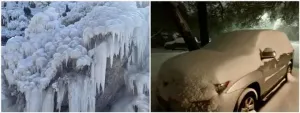How the brain processes sign language
2021-02-19
(Press-News.org) The ability to speak is one of the essential characteristics that distinguishes humans from other animals. Many people would probably intuitively equate speech and language. However, cognitive science research on sign languages since the 1960s paints a different picture: Today it is clear, sign languages are fully autonomous languages and have a complex organization on several linguistic levels such as grammar and meaning. Previous studies on the processing of sign language in the human brain had already found some similarities and also differences between sign languages and spoken languages. Until now, however, it has been difficult to derive a consistent picture of how both forms of language are processed in the brain.
Researchers at the MPI CBS now wanted to know which brain regions are actually involved in the processing of sign language across different studies - and how large the overlap is with brain regions that hearing people use for spoken language processing. In a meta-study recently published in the journal Human Brain Mapping, they pooled data from sign language processing experiments conducted around the world. "A meta-study gives us the opportunity to get an overall picture of the neural basis of sign language. So, for the first time, we were able to statistically and robustly identify the brain regions that were involved in sign language processing across all studies," explains Emiliano Zaccarella, last author of the paper and group leader in the Department of Neuropsychology at the MPI CBS.
The researchers found that especially the so-called Broca's area in the frontal brain of the left hemisphere is one of the regions that was involved in the processing of sign language in almost every study evaluated. This brain region has long been known to play a central role in spoken language, where it is used for grammar and meaning. In order to better classify their results from the current meta-study, the scientists compared their findings with a database containing several thousand studies with brain scans.
The Leipzig-based researchers were indeed able to confirm that there is an overlap between spoken and signed language in Broca's area. They also succeeded in showing the role played by the right frontal brain - the counterpart to Broca's area on the left side of the brain. This also appeared repeatedly in many of the sign language studies evaluated, because it processes non-linguistic aspects such as spatial or social information of its counterpart. This means that movements of the hands, face and body - of which signs consist - are in principle perceived similarly by deaf and hearing people. Only in the case of deaf people, however, do they additionally activate the language network in the left hemisphere of the brain, including Broca's area. They therefore perceive the gestures as gestures with linguistic content - instead of as pure movement sequences, as would be the case with hearing people.
The results demonstrate that Broca's area in the left hemisphere is a central node in the language network of the human brain. Depending on whether people use language in the form of signs, sounds or writing, it works together with other networks. Broca's area thus processes not only spoken and written language, as has been known up to now, but also abstract linguistic information in any form of language in general. "The brain is therefore specialized in language per se, not in speaking," explains Patrick C. Trettenbrein, first author of the publication and doctoral student at the MPI CBS. In a follow-up study, the research team now aims to find out whether the different parts of Broca's area are also specialized in either the meaning or the grammar of sign language in deaf people, similar to hearing people.
INFORMATION:
ELSE PRESS RELEASES FROM THIS DATE:
2021-02-19
The last complete reversal of the Earth's magnetic field, the so-called Laschamps event, took place 42,000 years ago. Radiocarbon analyses of the remains of kauri trees from New Zealand now make it possible for the first time to precisely time and analyse this event and its associated effects, as well as to calibrate geological archives such as sediment and ice cores from this period. Simulations based on this show that the strong reduction of the magnetic field had considerable effects in the Earth's atmosphere. This is shown by an international team led by Chris Turney from the Australian University of New South Wales, with the participation of Norbert Nowaczyk from the German Research Centre for ...
2021-02-19
Researchers at Tampere University have successfully used artificial intelligence to predict nonlinear dynamics that take place when ultrashort light pulses interact with matter. This novel solution can be used for efficient and fast numerical modelling, for example, in imaging, manufacturing and surgery. The findings were published in the prestigious Nature Machine Intelligence journal.
Artificial intelligence can distinguish different types of laser pulse propagation, just as it recognizes subtle differences of expression in facial recognition. The newly found solution can make it simpler to design experiments in fundamental research and will allow algorithms ...
2021-02-19
Carbon dioxide (CO2) electrocatalytic reduction driven by renewable electricity can solve the problem of excessive CO2 emissions. Since CO2 is thermodynamically stable, efficient catalysts are needed to reduce the energy consumption in the process.
The single-atom catalysts immobilized on nitrogen-doped carbon supports (M-N/C) have been widely used for CO2 electrocatalytic reduction reaction due to their high atom utilization efficiency.
Recently, a research team led by Prof. LIU Licheng from the Qingdao Institute of Bioenergy and Bioprocess Technology (QIBEBT) of the Chinese Academy of Sciences (CAS) proposed a two-step amination strategy to regulate the electronic structure of M-N/C catalysts (M=Ni, Fe, Zn) and enhance the intrinsic activity of CO2 electrocatalytic reduction.
In ...
2021-02-19
EUGENE, Ore. -- Feb. 19, 2021 -- Friction caused by dry Martian dust particles making contact with each other may produce electrical discharge at the surface and in the planet's atmosphere, according University of Oregon researchers.
However, such sparks are likely to be small and pose little danger to future robotic or human missions to the red planet, they report in a paper published online and scheduled to appear in the March 15 print issue of the journal Icarus.
Viking landers in the 1970s and orbiters since then detected silts, clays, wind-blown bedforms and dust devils on Mars, raising questions about potential electrical activity.
Scientists ...
2021-02-19
China is just one of many countries in the Northern Hemisphere having what researchers are calling an "extremely cold winter," due in part to both the tropical Pacific and the Arctic, according to an analysis of temperatures from Dec. 1, 2020, to mid-January of 2021. A country-specific case study, the investigation potentially has far-reaching implications for predictions and early warnings to protect against harmful impacts, researchers said.
The results were published online, ahead of print, on Feb. 12 in Advances in Atmospheric Sciences.
"We are trying to explain why the countries in the Northern Hemisphere ...
2021-02-19
Nanoparticles used in drug delivery systems, bioimaging, and regenerative medicine migrate from tissues to lymphatic vessels after entering the body, so it is necessary to clarify the interaction between nanoparticles and lymphatic vessels. Although technology to observe the flow of nanoparticles through lymphatic vessels in vivo has been developed, there has been no method to evaluate the flow of nanoparticles in a more detailed and quantitative manner ex vivo. Thus, research was conducted to develop an ex vivo lymphatic vessel lumen perfusion system to determine how nanoparticles move in lymphatic vessels and how they affect the physiological movement of lymphatic vessels.
Nanoparticles introduced into the ...
2021-02-19
A research team led by Prof. QIAN Peiyuan, Head and Chair Professor from the Hong Kong University of Science and Technology (HKUST)'s Department of Ocean Science and David von Hansemann Professor of Science, has published their cutting-edge findings of symbiotic mechanisms of a deep-sea vent snail (Gigantopelta aegis) in the scientific journal Nature Communications. They discovered that Gigantopelta snail houses both sulfur-oxidizing bacteria and methane-oxidizing bacteria inside its esophageal gland cells (part of digestive system) as endosymbionts. By decoding the ...
2021-02-19
A new study looking at how COVID-19 affects people with asthma provides reassurance that having the condition doesn't increase the risk of severe illness or death from the virus.
George Institute for Global Health researchers in Australia analysed data from 57 studies with an overall sample size of 587,280. Almost 350,000 people in the pool had been infected with COVID-19 from Asia, Europe, and North and South America and found they had similar proportions of asthma to the general population.
The results, published in the peer-reviewed END ...
2021-02-19
Researchers at the University of Illinois Chicago have discovered a way to convert the methane in natural gas into liquid methanol at room temperature.
This discovery, reported in the journal Proceedings of the National Academy of Sciences, could potentially provide a cleaner energy source for many of our everyday activities.
When burned, natural gas -- the fuel used to heat homes, cook food and generate electricity -- produces carbon dioxide, a powerful greenhouse gas.
According to the U.S. Energy Information Administration, the U.S. consumed approximately 31 trillion cubic feet of natural gas in 2019, contributing roughly 1.6 gigatons of carbon dioxide to the atmosphere.
A better way to use natural gas would be to convert it to methanol, a liquid fuel that burns more ...
2021-02-19
University of Queensland scientists have developed an ultraviolet 'television' display designed to help researchers better understand how animals see the world.
Until now, standard monitors on devices like televisions or computer screens have been used to display visual stimuli in animal vision studies, but none have been able to test ultraviolet vision - the ability to see wavelengths of light shorter than 400 nanometres.
Dr Samuel Powell, from the Queensland Brain Institute's Marshall lab, said this new technology will help unveil the secrets of sight in all sorts of animals, such as fish, birds and insects.
"Human TVs generally use three colours - red, green and blue - to create images, but our newly-developed ...
LAST 30 PRESS RELEASES:
[Press-News.org] How the brain processes sign language




